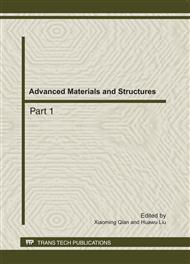p.176
p.182
p.187
p.191
p.195
p.199
p.203
p.207
p.212
Investigation of Phase Composition and Microstructure of the B4C/BN Nanocomposite Powders Fabricated by Chemical Reaction and Heat Treatment Process
Abstract:
The B4C/BN nanocomposite powders were fabricated by chemical reaction and heat treatment process in this research. The starting powders was composed of B4C powders, H3BO3 and CO(NH2)2. The mixture powders were reacted at 550°C for 15h and heat treated at 850°C for 6h. So the B4C/BN nanocomposite powders were prepared by above process. In this research, the B4C/BN nanocomposite powders were heat treated at 850°C, 1300°C, 1500°C, 1750°C. The phase composition and microstructure of the B4C/BN nanocomposite powders fabricated by heat treatment at high temperature were investigated by XRD and TEM. The XRD patterns results showed that there existed the B4C phase and amorphous BN phase after chemical reaction at 550°C and heat treatment at 850°C. Then the amorphous BN phase gradually transformed into the hexagonal BN (h-BN) phase with the increase of heat treatment temperature from 1300°C to 1750°C. The amorphous BN phase completely transformed into the h-BN phase after the hot-pressing process at 1850°C. The IR spectrum results showed that there existed the B4C phase and BN phase in the produced composite powders and sintered bulks. The microstructure of the synthesized B4C/BN composite powders showed that the B4C particles were surrounded with the amorphous BN coated layer after the heat treatment at 850°C, then the amorphous BN coated layer gradually transformed into the nano-sized h-BN particles with the increase of heat treatment temperature. So the B4C/BN nanocomposite powders were fabricated by chemical reaction and heat treatment process.
Info:
Periodical:
Pages:
195-198
Citation:
Online since:
September 2011
Authors:
Price:
Сopyright:
© 2011 Trans Tech Publications Ltd. All Rights Reserved
Share:
Citation:


